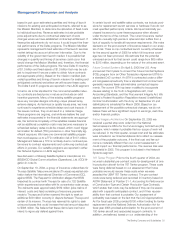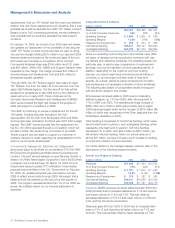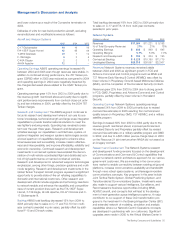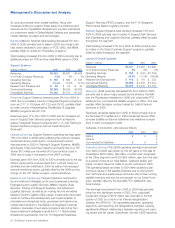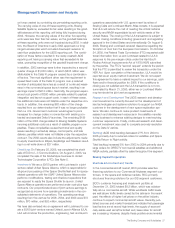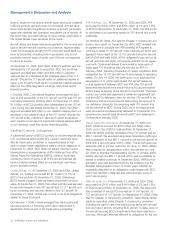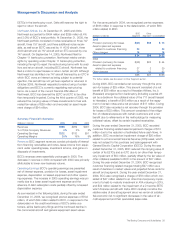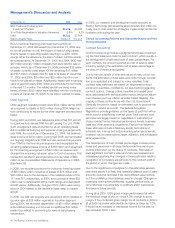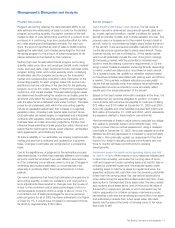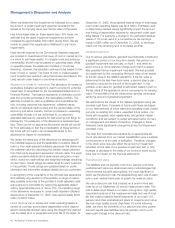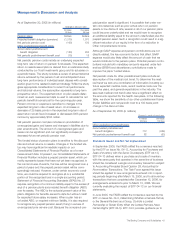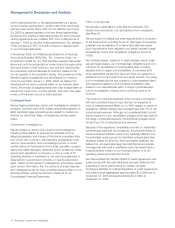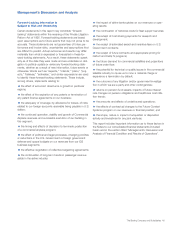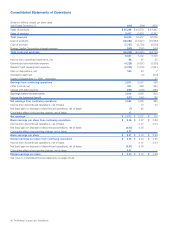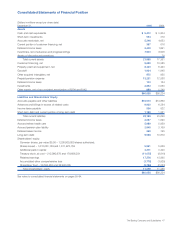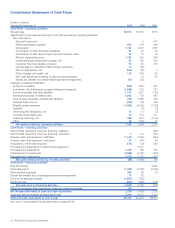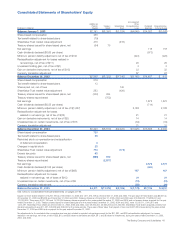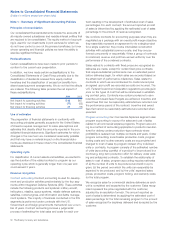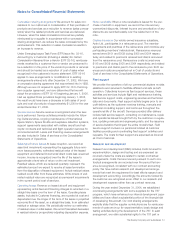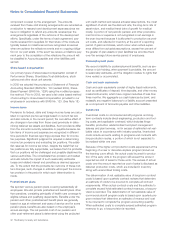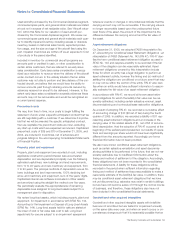Boeing 2005 Annual Report Download - page 45
Download and view the complete annual report
Please find page 45 of the 2005 Boeing annual report below. You can navigate through the pages in the report by either clicking on the pages listed below, or by using the keyword search tool below to find specific information within the annual report.
Management’s Discussion and Analysis
As of September 30, 2005 (in millions)
Change in discount rate
Increase Decrease
25 bps 25 bps
Pension plans Dollars Dollars
Projected benefit obligation (pensions) (1,370) 1,570
Net periodic pension cost (160) 150
Other postretirement benefit plans
Accumulated postretirement
benefit obligation (180) 200
Net periodic postretirement benefit cost (15) 15
Net periodic pension costs include an underlying expected
long-term rate of return on pension fund assets. This expected
return on assets assumption is derived from an extensive study
conducted by our Trust Investments group and its actuaries on
a periodic basis. The study includes a review of actual historical
returns achieved by the pension trust and anticipated future
long-term performance of individual asset classes with consid-
eration given to the related investment strategy. While the study
gives appropriate consideration to recent trust performance
and historical returns, the assumption represents a long-term
prospective return. The expected return on plan assets deter-
mined on each measurement date is used to calculate the net
periodic benefit (income)/cost for the upcoming plan year.
Pension income or expense is sensitive to changes in the
expected long-term rate of asset return. An increase or
decrease of 25 basis points in the expected long-term rate of
asset return would have increased or decreased 2005 pension
income by approximately $103 million.
Net periodic pension cost also includes an amortization of
unrecognized gains and losses and changes in liabilities due to
plan amendments. The amount of unrecognized gains and
losses can be significant and can significantly increase (or
decrease) future net periodic pension cost.
The funded status of pension plans is sensitive to the discount
rate and actual returns on assets. Changes in the funded sta-
tus may have significant immediate impacts on our
Consolidated Statements of Financial Position as of a new
measurement date. At present, our Consolidated Statements of
Financial Position includes a prepaid pension asset, which pri-
marily represents losses that have not yet been recognized. In
the normal course of events, the loss will be recognized over a
period of years and the prepaid pension asset will be corre-
spondingly reduced. However, under certain economic condi-
tions, we could be required to recognize all or a substantial
portion of the recognized loss in a single accounting period.
Statement of Financial Accounting Standards (SFAS) No. 87
requires recognition of a minimum liability equal to the excess (if
any) of a pension plan’s accumulated benefit obligation (ABO)
over its assets. The ABO is the actuarial present value of the
plan’s obligation for benefits earned to date but without credit
for expected future salary increases. When a plan has an
unfunded ABO, or required minimum liability, it is also required
to recognize any prepaid pension asset (if any) in excess of
unrecognized prior service cost. Because the company’s pre-
paid pension asset is significant, it is possible that under cer-
tain circumstances such as poor actual return on pension
assets or low discount rate, several or all of our pension plans
could become underfunded and we would have to recognize
an additional liability equal to the amount underfunded plus the
prepaid pension asset. Such a recognition could result in a sig-
nificant reduction of our equity in the form of a reduction in
Other comprehensive income.
Although GAAP expense and pension contributions are not
directly related, the key economic factors that affect GAAP
expense would also likely affect the amount of cash that we
would contribute to the pension plans. Potential pension contri-
butions include both mandatory amounts required under fed-
eral law (ERISA) and discretionary contributions made to
improve the plans’ funded status.
Net periodic costs for other postretirement plans include an
assumption of the medical cost trend. To determine the med-
ical trend we look at a combination of information including our
future expected medical costs, recent medical costs over the
past five years, and general expectations in the industry. The
assumed medical cost trend rates have a significant effect on
the amounts reported for the health care plans. In the following
table, we show the sensitivity of our other postretirement bene-
fit plan liabilities and net periodic cost to a 100 basis point
change in the discount rate.
As of September 30, 2005 (in millions)
Change in medical trend rate
Increase Decrease
100 bps 100 bps
Other postretirement benefit plans
Accumulated postretirement
benefit obligation 712 (624)
Net periodic postretirement benefit cost 62 (53)
Standards Issued and Not Yet Implemented
In September 2005, the FASB ratified the consensus reached
by the EITF on Issue No. 04-13, Accounting for Purchases and
Sales of Inventory with the Same Counterparty (EITF 04-13).
EITF 04-13 defines when a purchase and a sale of inventory
with the same party that operates in the same line of business
should be considered a single nonmonetary transaction subject
to Accounting Principles Board Opinion 29, Accounting for
Nonmonetary Transactions. The Task Force agreed this Issue
should be applied to new arrangements entered into in report-
ing periods beginning after March 15, 2006, and to all inventory
transactions that are completed after December 15, 2006, for
arrangements entered into prior to March 15, 2006. We are
currently evaluating the impact of EITF 04-13 on our financial
statements.
In June 2005, the FASB ratified the consensus reached by the
EITF on Issue No. 04-5, Determining Whether a General Partner,
or the General Partners as a Group, Controls a Limited
Partnership or Similar Entity When the Limited Partners Have
Certain Rights (EITF 04-5). EITF 04-5 provides guidance as to
The Boeing Company and Subsidiaries 43


